Scotland Travel Blog June 2024
”Charm of Galloway”
I don’t consider myself to be a “Hippie”. And I wouldn’t say I’m an overly “spiritual” person, but I do believe that there is something magical about being alone in a timeless landscape.
For me, that’s what makes Scotland special. The ability to get away from the modern world and soak up the atmosphere of a place where time stands still.
Galloway, in South West Scotland, is a good example of this.
It’s a region that you can visit in the height of Summer and still find places all to yourself. It also delivers a lot of the attractions that make people want to come to Scotland; castles, standing stones, whisky and scenery. So in this blog, I’m going to show you why you shouldn’t ignore this part of Scotland by detailing just a few of the things you could do with a 2 night stay in this forgotten corner.
DAY 1: Gatehouse of Fleet to Kirroughtree
This map shows you the route that we drove and the schedule is explained step by step in the text below.
The schedule below is based on how we paced the day when we explored this route.
Isle of Whithorn and St Ninians Chapel
09:00 - We started our day with a walk around Isle of Whithorn village.

When we visit this area, we normally base ourselves in the villages of Kirkcudbright or Gatehouse of Fleet. But this time we wanted to go more out of the way, and we wanted to check out a new B&B that looked really good. So, our starting point for these day trips was the Isle of Whithorn.
The name is a bit misleading as it isn’t an island. At least, not anymore thanks to a causeway that was built in the late 1700’s to form a sheltered anchorage. The causeway is now the “Main Street” which is lined with some attractive cottages that face onto the harbour.

It’s a quiet place with a nice pub / restaurant (with a brewery), a church, a community hall, and not much else. So the Isle of Whithorm has the sort of laid-back feel that I associate with island life.
The harbour is still home to a few Creel fishing boats and leisure craft, but it once would have been a much busier anchorage for boats carrying Pilgrims on their travels to nearby Whithorn.
So what’s the big deal with Whithorn, why would you go on a Pilgrimage there? Well, Whithorn is where Christianity started in Scotland with the arrival of St Ninian sometime in the early 5th century. Most people seem to think that St Columba kicked it all off in Iona, but he was around 150 years later.
The exact history of St Ninian is vague, but he was the first Christian missionary in Scotland, he made Whithorn his centre of operations and his tomb is believed to be somewhere underneath the ruins of Whithorn Priory. This all made Whithorn a big crowdpuller and anyone who was anyone made a pilgrimage here, including Robert the Bruce.
It remained a place of pilgrimage up until 1581, when such Papist activities were banned by the Scottish Reformation.
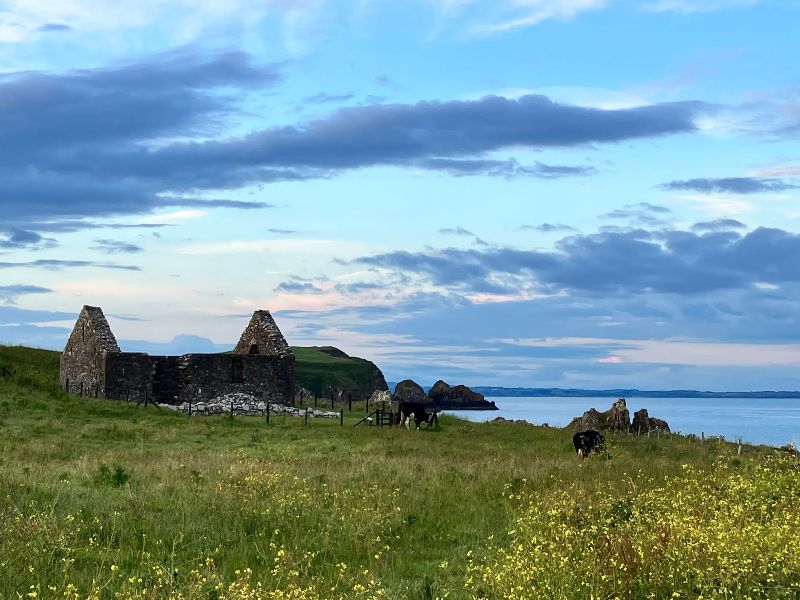
Before starting on this tour route, we recommend that you walk around the harbour at Isle of Whithorn, and follow the road through the car park, so you can pay a visit to the 11th Century ruins of St Ninian’s chapel which stand just a short distance from the rocky shore where pilgrims would have arrived near the end of their trek to Whithorn Priory.
It’s a modest but sturdy little building with a window that faces out to the sea. I imagine the Pilgrims would have stopped here to ask for a blessing before embarking on their journey home. They may also have stopped here on their arrival to give a relieved prayer of gratitude that they were back on terra firma as the Irish Sea can get pretty wild.

Just beside the chapel, there is a little stone-walled enclosure, like a sheep fank. In recent years, it has been used as a collection place for people to leave painted stones to commemorate passed loved ones. We’re not sure when this tradition started, but I don’t recall the memorial stones being here when I visited in 2009.
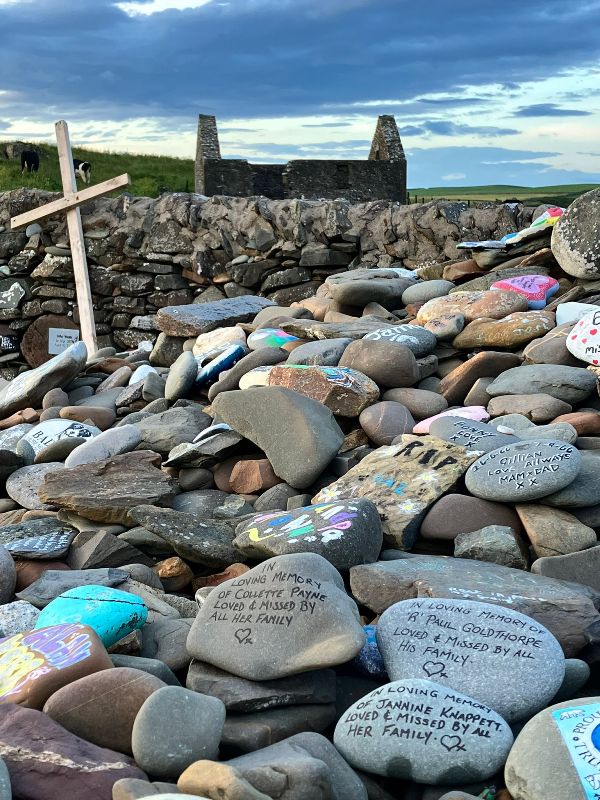
09:30 Depart Isle of Whithorn
Gatehouse of Fleet
10:30 - Arrive Gatehouse of Fleet
Gatehouse of Fleet is a neat little village which grew in size in the late 18th century due to the success of its cottons mills which were powered by waterwheels driven by the River Fleet. Its tidy terraces of cottages being the result of 18th century town planning.
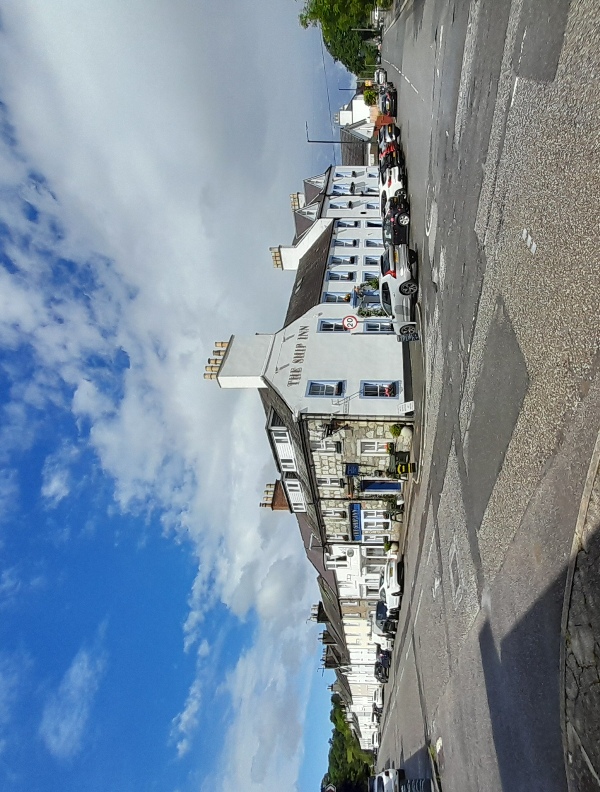
One of the watermills remains and now serves as the village museum. It also has a nice little cafe where you can sit outside to enjoy your coffee and cake beside the gently flowing river.

Our interest in visiting Gatehouse was not to see the town, but to seek out a stone with rare Pictish engravings on Trusty’s Hill to the west of Gatehouse. I’ve written previous blogs about Pictish carved stones and they are to be found in North East Scotland, so this stone in Galloway is a bit of an oddity.

From Gatehouse, you follow a trail that is signposted to Rutherford’s Monument. After 30 - 40 minutes of walking, you should be on the summit of Trusty’s Hill where it is easy to spot the Pictish Stone as it is protected by a large wrought iron cage. The markings on the stone appear to depict a dagger with ornate handle, a fire breathing serpent and some other unidentifiable symbols.

There’s no explanation for why a Pictish stone would appear so far from the home of the Picts, but my theory is that it might have been left by Picts making the Pilgrimage to St Ninian's crypt in Whithorn. After all, St Ninian is said to converted some of the Pictish clans to Christianity.
We continued our hike from the Pictish Stone by following a roughly triangular route that included stops at the pinnacle obelisk monument erected to the memory of local Minister, and distinguished 17th century academic, the Reverend Samuel Rutherford.

The trail then descends from Rutherford’s monument to the quaint ruins of Anwoth Church where he served as the minister from 1627 - 1638. This church is more famous for its appearance in the 1970’s classic cult film “The Wickerman”. If you plan to visit this area, it’s well worth watching the original “Wickerman” film before you come.

The walk of ~4 miles took us 1hr 45 mins, so we were back in Gatehouse around 12:15 with enough of an appetite for an early lunch.
Fortunately, Gatehouse enjoys a good choice of cafes and restaurants. If you just want something light there is the Iron Brew Cafe at the east end of the High Street opposite the clocktower, the riverside cafe at the watermill museum, Galloway Lodge cafe beside the main car park, or the Hungry Crow cafe in the old church beside the bridge over the River Fleet. We opted for the latter as we could grab a seat in the sun and they had some lovely salad options on the menu.

13:00 - Depart Gatehouse of Fleet
Cairnholy Chambered Cairn
13:20 - Arrive Cairnholy
Cairnholy is one of hidden gems of this region, and is up there with the Neolithic sites found on Orkney.

There are 2 chambered cairns at this site which is about 6 miles west of Gatehouse of Fleet and located high on a hillside near the end of a steep single-track road. It is thought that one of the cairns was used for burial ceremonies, whilst the other was where the remains were interred.

But the fascinating aspect of Cairnholy is the arrangement of standing stones at the entrance to the cairn where the ceremonies are thought to have taken place. The cairn was built around 6000 years ago and was a much larger structure than we see today. Originally, the line of 8 standing stones would have formed part of an east facing wall at the entrance to a long cairn made from many smaller stones piled on top of each other.
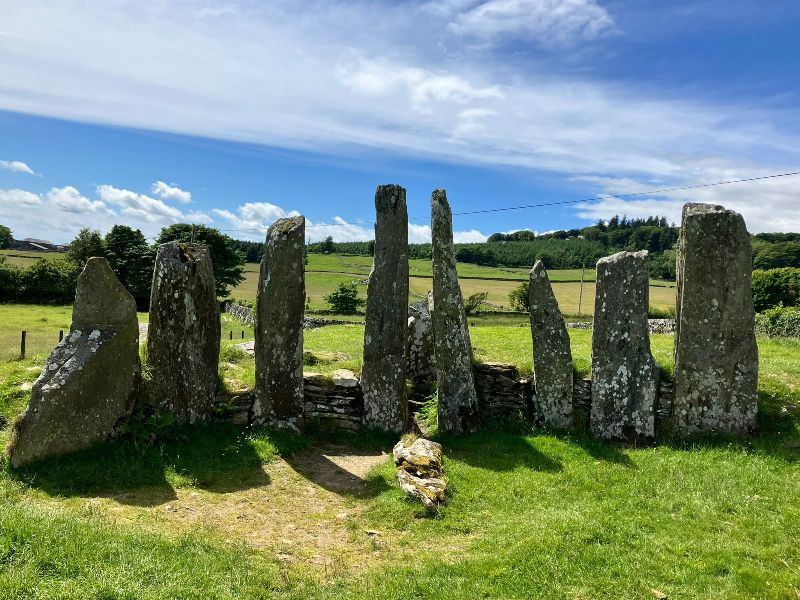
Over the centuries, these stones were removed by farmers to build walls as they were a good and easy source of building materials. So now, we are left with eight proud standing stones that project like teeth on either side of the entrance to the inner tomb.
What makes the arrangement of these stones interesting is their alignment with the setting sun as it traverses the sky between the Summer and Winter solstice. If you stand facing west at a specific point in front of the stones, the setting sun can be seen to align with a notch on the edge of the right-hand stone during the summer solstice, and during Sunset on the Winter Solstice, the same occurs with the tip of the stone on the left. But there’s more, for at sunrise on the summer solstice, the back stone of the burial chamber is illuminated by sunlight.

The burial chamber was carefully excavated in 1949 and among the interesting objects found was a piece of a ceremonial axe made from Jadeite, a stone that must have been imported from the Alps. So whoever made these stones were sophisticated people communicating and trading across continents. It makes you wonder.
13:35 - Depart Cairnholy
Kirroughtree Mountain Bike Trails
14:20 - Arrive Kirroughtree Visitor Centre
When you are touring with a teenage kid, you have to balance the old stones and “Boring stuff”, with some fun activities to burn off energy. Fortunately, Galloway has quite a few good facilities for activities that will keep a 13-year old boy happy. The mountain bike trails at Kirroughtree Forest are a good example of this and were next on our itinerary.
We’ve cycled quite a few of the forest trails in the Galloway Forest Park, but most of those trails are forest roads so not technically challenging, but physically exerting. At Kirroughtree you get physical exertion, technical challenge, and a wee bit of roller coaster terror.

It’s a great facility with a lovely modern visitor centre where you can get snacks and a well-stocked bike shop where you can hire some very good bikes. We took our own bikes, but I was tempted to hire since my bike was bought second-hand from a bike hire shop and it is well sh*gged. I was getting looks of sympathy from the serious mountain bikers.

There are 3 grades of trail. We played safe and stuck to the blue trails, but we had a try on some of the red trail sections and decided that blue was quite enough excitement for us “oldies”. Junior was in his element and was much less daunted by the prospect of a high-speed impact with a tree.
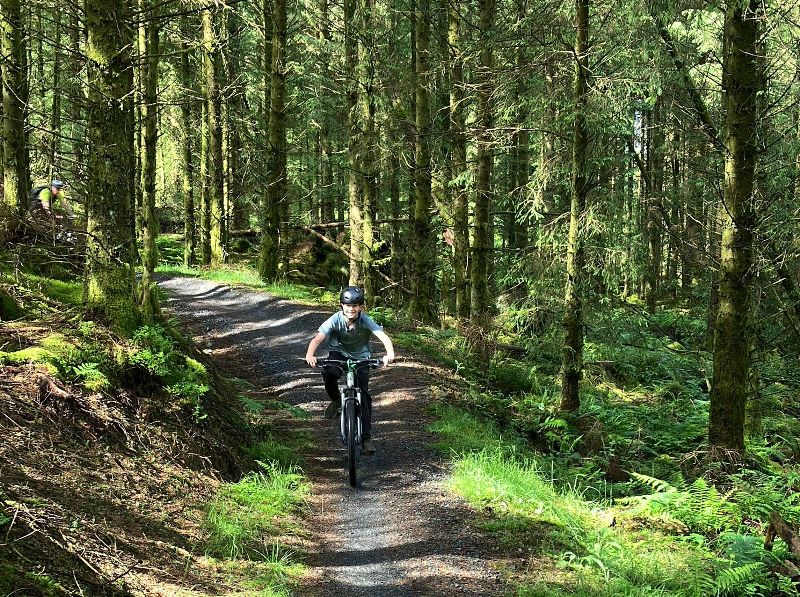
It took us ~2.5 hours to complete a circuit of the blue trail and get the bikes reloaded on the car (never a quick or easy task). By this stage of the day, we were all quite muddy, tired, and looking forward to our dinner which we’d booked at the Steam Packet Inn back at Isle of Whithorn.
16:50 - Depart Kirroughtree
17:30 - Arrive back at Isle of Whithorn
Dinner at Steam Packet Inn - I don’t normally post pictures of my dinner, mainly because I feel a bit of a pillock taking photos of food in restaurants, I leave that stuff to the professional Instagrammers. But the food was so well presented at the Steam Packet that I think the chef deserves some acknowledgment of his fine work.

I’d also like to air my appreciation of the “Juicy IPA” produced by the Five Kingdoms brewery at the Steam Packet Inn. What a lovely way to end a lovely day. And the village harbour was looking idyllic in the evening light as we walked back to our B&B.

DAY 2: The Machars and Mull of Galloway
This touring route has a mix of attractions from old curiosities to an aviation museum where you get the chance to climb into aircraft cockpits. We realise that planes aren’t everyone’s thing, so we’ve included some other places in the touring route where you could also spend time.
09:00 - Depart Isle of Whithorn
St Ninian’s Cave
09:15 - Arrive Car Park
We started our other suggested tour route with a visit to St Nininan’s chapel, so we’re continuing that theme with a visit to the cave which St Ninian is said to have used as a quiet retreat when he needed some time for meditation.
There is a coastal path from Isle of Whithorn to the cave, but that’s a hike of ~8 miles and we had lots that we wanted to pack into our day. So, we opted for a much shorter 1 mile hike from a car park near some lovely old farm buildings at Kidsdale. The car park has an honesty box with donations going towards the maintenance of the path to the cave, so please stick in a few pound coins if you go here.

The path to the cave is an easy walk that takes you down to the shore via the course of a burn that passes through mature woodland. You meet the sea at a pebble beach and the route to the cave is clearly signposted, but you don’t really need this guidance as the cave entrance is quite easy to spot against a cliff face of blonde sandstone.

There’s no hard evidence that St Ninian did use this cave, but the story must have drawn pilgrims here for the cave walls have several crosses carved into them. It’s easy to believe that St Ninian would have chosen this cave as it stands high enough above the sea to be safe from flooding, and the entrance is quite sheltered from the wind by the surrounding rocks.
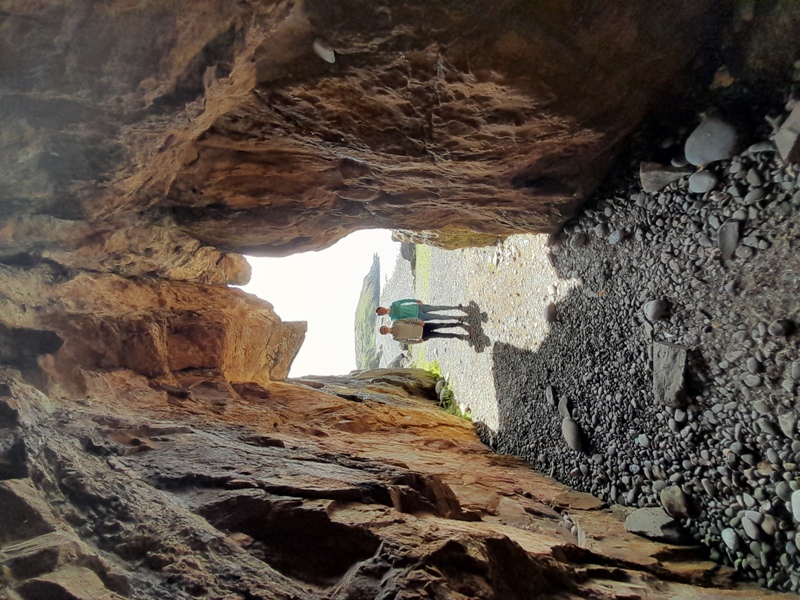
The walk to and from the cave won’t take you more than 45 minutes and the path is mainly dry. We suggest you allow about an hour for this as you’ll probably stop to take quite a few photos and might also enjoy a bit of rock balancing…there’s lots to choose from.

10:10 - Depart
Drumtroddan Standing Stone
10:25 - Arrive Drumtroddan
We’ve already mentioned Cairnholy Chambered Cairn, and if there is only one ancient site you visit in Galloway we recommend that that’s the place you go. But if you are passing by Drumtroddan Stone, you might as well give it a quick stop as it’s easy to access and is quite an impressively tall stone.

The stone stands on top of a hill that lies about 2 miles east of Port William, and near the intersection of the B7021 and B7085. There are no signposts for the standing stone and there is no official car park as the stone is located in the middle of a farmer’s field.
At the time of our visit, the field had just been tilled, but the farmer had left an access track that led up to the fenced-off enclosure where the stones are found. I say stones as there are two fallen stones beside the one that remains upright. Unfortunately, since two of the stones are down, archaeologists can only speculate if they had any solar or lunar alignment. What you can still appreciate from their location is that the site was chosen for its commanding views over the surrounding landscape.

There are cup and ring-marked stones not far from the Standing Stone, but we had a busy schedule to stick to. So, that will have to wait for another trip…
Moving on!
10:40 - Depart
Druchtag Mote
10:48 - Arrive Druchtag Motte
If you look at Ordnance Survey maps, you quite often see a “Motte” indicated in strange Gothic font. More often than not, these mottes are quite disappointing grassy mounds that you’d pass by without a second glance. There are some notable exceptions. The Peel Ring of Lumphanan in Aberdeenshire is one, and so is Druchtag Motte just outside the village of Mochrum.

Druchtag Motte is a steep-sided manmade hill with a surrounding ditch that might once have been flooded. On top of the hill, there would have been some form of timber castle. You get the picture if you can recall the scene in “Braveheart” where Mel Gibson captures an English fort by dressing up as an English soldier.
What the movie didn’t really depict is how steep the sides of these Motte’s can be. Mel would have been struggling to catch his breath after climbing up the side of Druchtag Motte. It’s so steep that they’ve had to attach a rope so you can pull yourself up.

11:00 - Depart
Galloway House Gardens
11:20 - Arrive Galloway House
Galloway House is located just south of the pretty village of Garlieston on the shores of Cruggleton Bay. The house is surrounded by large gardens which are open to the public and the only admission fee is a modest parking charge, which can be paid by card at a ticket machine.
The best time to visit these gardens is Spring as the floral displays start with Snowdrops and then peak in May when the Rhododendrons are in full bloom. But if you visit at other times of year, you can still enjoy avenues of towering Douglas Fir trees and a labyrinth of paths that weave through the extensive grounds down to Rigg Bay.
Rigg Bay has a link to the D-Day Landings as it was here that they tested the different designs of “Mulberry” floating harbours that played such a crucial part in the supply of the D-Day beach-head. There are a few rusting traces of the WW2 structures, but not enough to make it worthwhile as a visit for WW2 enthusiasts.
Sadly, the 8-acre site of the walled gardens is currently out of bounds until funds can be raised to stabilise the walls and repair a section damaged by a falling tree. The house, a former home of the Earls of Galloway, is also out of bounds as it is privately owned and lived in.

If it’s a sunny day, we’d suggest planning to stay here for a picnic. And if you keep quiet, you might be treated to a visit from one of the Roe deer that are resident in the gardens. They’re very nervous creatures, but we spotted 2 during our wander in the grounds.
12:00 - Depart
Bladnoch Distillery/ Cafe Melba
12:15 - Arrive Bladnoch Distillery / Wigtown
We didn’t get picnic weather, but we had a Plan B and that was to get lunch at the Melba Cafe in Bladnoch Distillery. We just stopped for lunch, but this is one of the options in this tour route where you adjust the schedule by spending a couple of hours enjoying a distillery tour and tasting session.
Bladnoch Distillery has the claim to fame of being the most southerly distillery in Scotland. Founded in 1817, it has, like so many distilleries, had its fair share of good times and hard times. In recent years, the distillery has enjoyed a bit of a renaissance under the ownership of Australian David Prior, who bought the business in 2015.
David has brought a new energy to the Bladnoch brand with several new “expressions” of Bladnoch being released since his takeover. He’s also invested in the distillery facilities with the refurbishment of the distillery cafe being a recent upgrade. Cafe Melba is a lovely place to stop for a light lunch or just a bit of cake, and the cafe is stylish in a modern, minimalist, IKEA sort of way.
The cafe is open Tues - Sat from 10am - 4pm. If you prefer a more traditional cafe, there are a few to choose from in nearby Wigtown, which is known as the “Book town” due to its cluster of bookshops.
13:15 - Depart
Stoneykirk Aviation Museum
14:00 - Arrive Stoneykirk Aviation Museum
Again, when you are travelling with teenage son, you have to get the balance right to keep everyone happy. Fortunately, he’s an aviation enthusiast and this corner of Scotland has one of our favourite Avaiation museum’s at Stoneykirk, which is not far from M.o.D’s weapon’s range at West Freugh.
We’ve visited quite a few Aircraft Museums in our time, including the big ones at Hendon, Duxford, and Cosford. The big museums always have some interesting and rare aircraft on display, but they leave me feeling a bit frustrated that you seldom get the chance to sit in a cockpit. At Stoneykirk Aviation Museum, the experience is different as they encourage you to climb on board.

The museum is literally on a farm, and it’s a charmingly “homely” affair that’s only open on Sunday's, unless you make a special appointment. There aren’t any complete aircraft here, instead, it is a collection of 8 cockpit sections, and most are set up so that you can climb into them (under supervision).
The museum has a small exhibition area telling the story of its main attraction, the Avro Vulcan B1. There are also some displays of aircraft equipment and information about the aviation history of the surrounding area. You then walk across the farmyard and enter a shed where a collection of cockpits is held.
The aircraft featured in the collection are primarily military jets from the Cold War. So, in addition to the showpiece Vulcan, there are 2 Blackburn Buccaneers, a Canberra Bomber, a Sea Vixen, Sea Hawk, Jet Provost, and Vampire.

A very knowledgeable guide is on hand (sorry, I didn’t get his name) and he can give you a lot of in-depth details about the aircraft. From his level of knowledge, I assumed he was retired RAF personnel. He was also very patient with visitors and was more than happy to take the time to let my son and I climb into the pilot’s seat of the Vulcan and Buccaneer.
It’s quite something to experience how cramped and surprisingly rudimentary the Vulcan feels inside. You can imagine how daunting an aircraft it would have been to fly and the idea of going to war in it is frightening as the visibility from the cockpit is so limited.

When we visited, the admission price was a very reasonable £6 per adult, and £3 per child. I consider that value for money for the novelty of the experience.
15:00 - Depart
Mull of Galloway Lighthouse
15:35 - Arrive Mull of Galloway visitor centre
We realise that Aircraft Museums aren’t going to appeal to everyone, and the museum is only open on Sundays in Summer, so here’s another option.
The Mull of Galloway lighthouse stands close to the most southerly tip of the Scottish mainland and that fact alone might make you want to visit here. It’s also a scenic drive down the Mull of Galloway and the lighthouse is every bit as photogenic as the Neist Lighthouse on Skye.
We’d argue that this is better to visit than Neist as it has a visitor centre, with a really good cafe, ample car parking and, for a small fee, you can climb the lighthouse stairs to get a view across the sea to Northern Ireland.
And if lighthouses aren’t your thing either, there are several other attractions on the Mull of Galloway that we’ve written about in this previous Blog.
16:45 - Depart Mull of Galloway Lighthouse
18:00 - Arrive back at Isle of Whithorn
I hope this blog has opened your mind to the idea of exploring South West Scotland, you might like to consider our "Scottish Inspirations" tour plan which gives even more ideas for a holiday around the overlooked corners of Southern Scotland.






